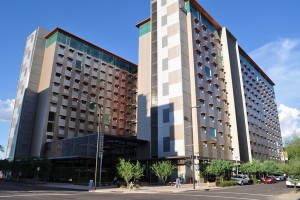 October 15 is Blog Action Day
October 15 is Blog Action Day
, and this year’s topic, climate change, got me thinking of how Downtown Phoenix is trying to make a difference. I started making a mental list of all of the innovations in recent years, and kept coming back to one place: ASU’s Downtown campus.
It’s no secret that ASU president Michael Crow has green on the brain, and he has made it the university’s mission to pursue any and all green innovations full throttle. What initiative could be more important smack in the middle of the Sonoran Desert than water conservation? Luckily, ASU is already helping us conserve every day. Just take a look at the collection of new buildings that focus on conservation, preservation and reuse.
Arizona Biomedical Collaborative
A lot of water flows through a building that is more than 85,000 square feet. So, when ASU and U of A drew up plans for this massive biomedical facility, keeping water use to a minimum was high on the list of needed features. Up for LEED designation, the Biomedical Collaborative reduces potable water by 40% with low-flow and dry fixtures. Outside, in the dry desert air, the conservation is even more important. The Biomedical Collaborative utilizes high-efficiency irrigation, along with the use of native and adaptive plants to reduce potable water usage for landscaping by 63%.
Walter Cronkite School of Journalism and Mass Communication/KAET 8 Building
The Cronkite School building has quickly changed the Downtown Phoenix skyline, and it’s trying to change the way we conserve water as well. The building, set to be designated LEED Silver, is designed with the same low-flow and dry fixtures as the Biomedical Collaborative, but it also has a rooftop rainwater retrieval system that stores the rain that falls on the Valley, allowing for reuse within the building at a later time. We don’t get much rain here, so we might as well keep it!

Taylor Place
Taylor Place
The Downtown Phoenix campus’ dormitories, Taylor Place, may look like a typical high-rise residential unit, but the desert climate was a big factor in the towers’ design. Drought-tolerant plants, watered by a condensate byproduct of the air conditioning system, were planted throughout the grounds. Dual-flush toilets and low-flow fixtures were installed in every restroom. Even the major appliances in Taylor Place are Energy Star approved, conserving both water usage and electricity.
This is just the beginning. The newly finished Nursing and Healthcare Innovation building will soon be up for LEED designation. Civic Space Park, adjacent to ASU, will reach 70% shade coverage upon vegetation maturity. And, you can bet any and all future improvements and new builds by the university will have this same conservation approach in mind.






Interesting thing about Taylor Place, they won’t allow small biz to leave flyers or posters there, saying they want to be so green. BUT they did offer to do “electronic bulletin board” notices, which I still don’t know where to send or format etc etc…meanwhile, aren’t large screen bulletin board TVs that are on 24/7 less green(high use electricity, disposal factor)than simply placing a blue can named “Recycle” next to the flyer rack?
That’s rather interesting that you mention that. I’m going to ask around and see if I can find a reasoning behind that.